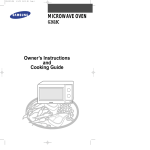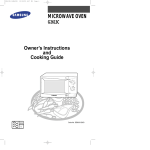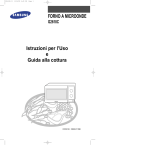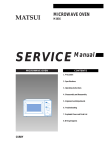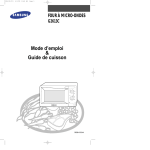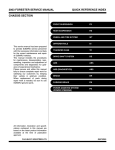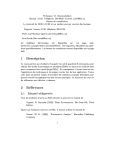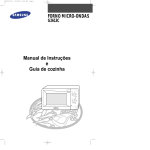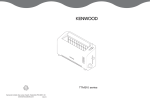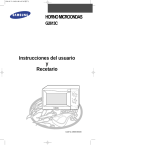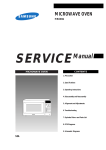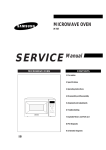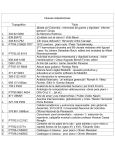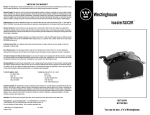Download Samsung G633C Manuel de l'utilisateur
Transcript
G635C/G633C1(GB) 8/11/00 7:45 PM Page 1 MICROWAVE OVEN G635C/G633C Owner’s Instructions and Cooking Guide QUARTZ GRILL G635C/G633C1(GB) 8/11/00 7:45 PM Page 1 You have just purchased a SAMSUNG microwave oven. GB Your Owner’s Instructions contain much valuable information on cooking with your microwave oven. Take the time to read them as they will help you take full advantage of the microwave oven features. Contents ◆ OVEN (G635C) ........................................................................................................ 2 ◆ CONTROL PANEL (G635C) ...................................................................................... 3 ◆ OVEN (G633C) ...................................................................................................... 4 ◆ CONTROL PANEL (G633C) ...................................................................................... 5 ◆ USING THIS INSTRUCTIONS BOOKLET ........................................................................ 6 ◆ INSTALLING AND PREPARING YOUR MICROWAVE OVEN ■ ■ ■ ■ ■ ■ Safety Precautions ........................................................................................ Accessories ................................................................................................... Installing Your Microwave Oven .................................................................... How a Microwave Oven Works ..................................................................... Checking that Your Oven is Operating Correctly........................................... What to Do if You are in Doubt or Have a Problem....................................... 7 9 10 11 11 12 ◆ COOKING WITH YOUR MICROWAVE OVEN ■ ■ ■ ■ ■ ■ Cooking/Reheating ........................................................................................ Stopping the Cooking .................................................................................... Adjusting Extra Time ..................................................................................... Manual Defrosting Food ................................................................................ Instant Reheat Guide..................................................................................... Power Level and Time Variations.................................................................. 13 14 14 15 15 16 ◆ TRADITIONAL COOKING METHODS ■ Grilling ........................................................................................................... 17 ◆ RECOMMENDATIONS FOR USE ■ ■ ■ ■ ■ CookWare Guide ........................................................................................... Cooking Guide............................................................................................... Cleaning Your Microwave Oven .................................................................... Storing and Repairing Your Microwave Oven ............................................... Technical Specifications ................................................................................ 1 18 19 25 25 26 G635C/G633C1(GB) 8/11/00 7:45 PM Page 2 OVEN (G635C) GB TIMER KNOB VENTILATION HOLES VARIABLE COOKING POWER CONTROL KNOB HEATING ELEMENT VENTILATION HOLES 400 240 560 800W 120 0 1 2 60 3 50 DOOR LATCHES 4 40 5 30 6 20 7 10 9 8 G635C OPEN DOOR PUSH BUTTON DOOR ROLLER RING GLASS PLATE SAFETY INTERLOCK HOLES COUPLER 2 G635C/G633C1(GB) 8/11/00 7:45 PM Page 3 Control Panel (G635C) GB 400 240 560 DEFROST 800W 120 0 1 2 60 3 INSTANT COOK 50 4 40 5 30 6 20 7 10 9 8 G635C OPEN DOOR PUSH BUTTON 3 G635C/G633C1(GB) 8/11/00 7:45 PM Page 4 OVEN (G633C) GB TIMER KNOB VENTILATION HOLES HEATING ELEMENT VARIABLE COOKING POWER CONTROL KNOB VENTILATION HOLES 400 560 240 800W 120 0 1 2 3 60 50 DOOR LATCHES 4 40 5 30 6 7 20 10 9 8 G633C COUPLER ROLLER RING DOOR GLASS PLATE 4 OPEN DOOR PUSH BUTTON SAFETY INTERLOCK HOLES G635C/G633C1(GB) 8/11/00 7:45 PM Page 5 Control Panel (G633C) GB DEFROST INSTANT COOK OPEN DOOR PUSH BUTTON 5 G635C/G633C1(GB) 8/11/00 7:45 PM Page 6 Using this Instructions Booklet GB You have just purchased a SAMSUNG microwave oven. Your Owner’s Instructions contain much valuable information on cooking with your microwave oven: ◆ Safety precautions ◆ Suitable accessories and cookware ◆ Useful cooking tips At the front of the booklet you will find illustrations of the oven, and more importantly the control panel, correspanding to your microwave model type. The step-by-step procedures use two different symbols. ☛ ➢ Important Note PRECAUTIONS TO AVOID POSSIBLE EXPOSURE TO EXCESSIVE MICROWAVE ENERGY Failure to observe the following safety precautions may result in harmful exposure to microwave energy. (a) Under no circumstances should any attempt be made to operate the oven with the door open or to tamper with the safety interlocks (door latches) or to insert anything into the safety interlock holes. (b) Do not place any object between the oven door and front face or allow food or cleaner residues to accumulate on sealing surfaces. Ensure that the door and door sealing surfaces are kept clean by wiping after use first with a damp cloth and then with a soft dry cloth. (c) Do not operate the oven if it is damaged until it has been repaired by a qualified microwave service technician trained by the manufacturer. It is particularly important that the oven door closes properly and that there is no damage to the: (1) Door, door seals and sealing surfaces (2) Door hinges (broken or loose) (3) Power cable (d) The oven should not be adjusted or repaired by anyone other than a properly qualified microwave service technician trained by the manufacturer. 6 G635C/G633C1(GB) 8/11/00 7:45 PM Page 7 Safety Precautions GB Before cooking food or liquids in your microwave oven, please check that the following safety precautions are taken. 1 DO NOT use any metallic cookware in the microwave oven: ◆ ◆ ◆ Metallic containers Dinnerware with gold or silver trimmings Skewers, forks, etc. Reason: Electric arcing or sparking may occur and may damage the oven. 2 DO NOT heat: ◆ Airtight or vacuum-sealed bottles, jars, containers Example: Baby food jars ◆ Airtight food Example: Eggs, nuts in shells, tomatoes Reason: The increase in pressure may cause them to explode. Tip: 3 Remove lids and pierce skins, bags, etc. DO NOT operate the microwave oven when it is empty. Reason: The oven walls may be damaged. Tip: 4 Leave a glass of water inside the oven at all times. The water will absorb the microwaves if you accidentally set the oven going when it is empty. DO NOT cover the rear ventilation slots with cloths or paper. Reason: The cloths or paper may catch fire as hot air is evacuated from the oven. 5 ALWAYS use oven gloves when removing a dish from the oven. Reason: Some dishes absorb microwaves and heat is always transferred from the food to the dish. The dishes are therefore hot. 6 DO NOT touch heating elements or interior oven walls. Reason: These walls may be hot enough to burn even after cooking has finished, although they do not appear to be so. Do not allow inflammable materials to come into contact with any interior area of the oven. Let the oven cool down first. 7 To reduce the risk of fire in the oven cavity: ◆ Do not store flammable materials in the oven ◆ Remove wire twist ties from paper or plastic bags ◆ Do not use your microwave oven to dry newspapers ◆ If smoke is observed, keep the oven door closed and switch off or disconnect the oven from the power supply 7 G635C/G633C1(GB) 8/11/00 7:45 PM Page 8 Safety Precautions (continued) GB 8 Take particular care when heating liquids and baby foods. ◆ ◆ ◆ ◆ ◆ ◆ ◆ 9 NEVER fill the container to the top and choose a container that is wider at the top than at the bottom to prevent the liquid from boiling over. Bottles with narrow necks may also explode if overheated. ALWAYS check the temperature of baby food or milk before giving it to the baby. NEVER heat a baby’s bottle with the teat on, as the bottle may explode if overheated. Be careful not to damage the power cable. ◆ ◆ 10 ALWAYS allow a standing time of at least 20 seconds after the oven has been switched off to allow the temperature to equalize. Stir during heating if necessary and ALWAYS stir after heating. To prevent eruptive boiling and possible scalding, you should stir before, during, and after heating. In the event of scalding, follow these FIRST AID instructions: • Immerse the scalded area in cold water for at least 10 minutes. • Cover with a clean, dry dressing. • Do not apply any creams, oils or lotions. Do not immerse the power cable or plug in water and keep the power cable away from heated surfaces. Do not operate this appliance if it has a damaged power cable or plug. Stand at arm’s length from the oven when opening the door. Reason: The hot air or steam released may cause scalding. 11 Keep the inside of the oven clean. Reason: Food particles or spaltered oils stuck to oven walls or floor can cause the damage of painting and reduce the efficiency of the oven. 12 “Clicking” sound might be noticed while operating, especially at defrosting mode. Reason: When the power output is changing electrically, you may hear that sound. This is normal. 13 When the microwave oven is operating without any load, the power will be cut off automatically for safety. After standing over 30 min, you can operate the oven normally. IMPORTANT SAFETY INSTRUCTIONS During cooking, you should look into the oven from time to time when food is being heated or cooked in disposable containers of plastic, paper or other combustible materials. IMPORTANT Young children should NEVER be allowed to use or play with the microwave oven. Nor should they be left unattended near the microwave oven when it is in use. Items of interest to children should not be stored or hidden just above the oven. 8 G635C/G633C1(GB) 8/11/00 7:45 PM Page 9 Accessories GB Depending on the model that you have purchased, you are supplied with several accessories that can be used in a variety of ways. 1 1 Coupler, already placed over the motor shaft in the base of the oven. Purpose: The coupler rotates the glass plate. 2 Roller ring, to be placed in the centre of the oven. 2 Purpose: The roller ring supports the glass plate. 3 Glass plate, to be placed on the roller ring with the centre fitting on to the coupler. Purpose: The glass plate serves as the main cooking surface; it can be easily removed for cleaning. 4 3 Metal rack, to be placed on the glass plate. Purpose: The metal rack can be used to cook two dishes at the same time. A small dish may be placed on the glass plate and a second dish on the rack. The metal rack can be used in grill and combination cooking ☛ 4 DO NOT operate the microwave oven without the roller ring and the glass plate. 9 G635C/G633C1(GB) 8/11/00 7:45 PM Page 10 Installing Your Microwave Oven GB Place the oven on a flat, level surface strong enough to safely bear the weight of the oven. 20 cm above 10 cm behind QUARTZ GRILL 10 cm on the side 1 When you install your oven, Make sure there is adequate ventilation for your oven by leaving at least 10 cm (4 inches) of space behind, on the sides of the oven and 20 cm (8 inches) of above. 2 Remove all packing materials inside the oven. Install the roller ring and turntable. Check that the turntable rotates freely. ☛ Never block the air vents as the oven may overheat and automatically switch itself off. It will remain inoperable until it has cooled sufficiently. ☛ For your personal safety, plug the cable into a 3-pin, 230 Volt, 50Hz, AC earthed socket. If the power cable of this appliance is damaged, it must be replaced by a special cable (I-SHENG SP022, KDK KKP4819D, EUROELECTRIC 3410, SAMIL SP-106B, MOONSUNG EP-48E). Contact your local dealer to have it replaced. The power cable of ISRAEL is PENCON(ZD16A), S/AFRICA APEX LEADS SA16 and NIGERIA, GHANA, KENYA and U.A.E is PENCON(UD13A1). ☛ Do not install the microwave oven in hot or damp surroundings like next to a traditional oven or radiator. The power supply specifications of the oven must be respected and any extension cable used must be of the same standard as the power cable supplied with the oven. Wipe the interior and the door seal with a damp cloth before using your microwave oven for the first time. 10 G635C/G633C1(GB) 8/11/00 7:45 PM Page 11 How a Microwave Oven Works GB Microwaves are high-frequency electromagnetic waves; the energy released enables food to be cooked or reheated without changing either the form or the colour. You can use your microwave oven to: ◆ Defrost ◆ Reheat ◆ Cook Cooking Principle 1 The microwaves generated by the magnetron are distributed uniformly as the food rotates on the glass plate. The food is thus cooked evenly. 2 The microwaves are absorbed by the food up to a depth of about 1 inch (2.5 cm). Cooking then continues as the heat is dissipated within the food. 3 Cooking times vary according to the recipient used and the properties of the food: ◆ Quantity and density ◆ Water content ◆ Initial temperature (refrigerated or not) ☛ As the centre of the food is cooked by heat dissipation, cooking continues even when you have taken the food out of the oven. Standing times specified in recipes and in this booklet must therefore be respected to ensure: ◆ Even cooking of the food right to the centre ◆ The same temperature throughout the food Checking that Your Oven is Operating Correctly The following simple procedure enables you to check that your oven is working correctly at all times. If you are in doubt, refer to the section entitled “What to Do if You are in Doubt or Have a Problem” on the next page. ➢ ◆ ◆ ◆ The oven must be plugged into an appropriate wall socket. The glass plate must be in position in the oven. If a power level other than the maximum is used, the water takes longer to boil. 1 Open the oven door. Place a bowl of water on the glass plate. Close the door. 2 Set the power level to maximum by turning COOKING POWER CONTROL knob. 3 Set the time to 4 to 5 minutes by turing the TIMER knob. G635C G633C G635C G633C 11 G635C/G633C1(GB) 8/11/00 7:45 PM Page 12 What to Do if You are in Doubt or Have a Problem GB Becoming familiar with a new appliance always takes a little time. If you have any of the problems listed below, try the solutions given. They may save you the time and inconvenience of an unnecessary service call. Problem ◆ ◆ ◆ ◆ Condensation inside the oven Air flow around the door and outer casing Light reflection around the door and outer casing Steam escaping from around the door or vents Checks/Explanation/Solution This is normal. The oven does not start when you turn the TIMER knob. ◆ Is the door completely? The food is not cooked at all ◆ Have you set the timer correctly? ◆ Is the door closed? ◆ Have you overloaded the electric circuit and caused a fuse to blow or a breaker to be triggered? The food is either overcooked or undercooked ◆ Was the appropriate cooking length set for the type of food? ◆ Was an appropriate power level chosen? Sparking and cracking occur inside the oven (arcing) ◆ Have you used a dish with metal trimmings? ◆ Have you left a fork or other metal utensil inside the oven? ◆ Is aluminium foil too close to the inside walls? The oven causes interference with radios or televisions ◆ Slight interference may be observed on televisions or radios when the oven is operating. This is normal. Solution: Install the oven away from televisions, radios and aerials. If the above guidelines do not enable you to solve the problem, take a note of: ◆ The model and serial numbers, normally printed on the rear of the oven ◆ Your warranty details (date and place of purchase) ◆ A clear description of the problem Then contact your local dealer or SAMSUNG after-sales service. 12 G635C/G633C1(GB) 8/11/00 7:45 PM Page 13 Cooking/Reheating GB The following procedure explains how to cook or reheat food. ☛ ALWAYS check your cooking settings before leaving the oven unattended. 1 Open the oven door by pushing the large button in the button right-hand corner of the control panel. Place the food in the centre of the glass plate. Close the door. 2 Set the power level to maximum by turning COOKING POWER CONTROL knob. 3 Model G635C/G633C MAXIMUM POWER 800W G635C G633C G635C G633C Set the time by turning TIMER knob. Result: ➢ The oven light comes on and the glass plate starts rotating. Cooking starts. You can change the power level during cooking by turning the COOKING POWER CONTROL knob. 13 G635C/G633C1(GB) 8/11/00 7:45 PM Page 14 Stopping the Cooking GB You can stop cooking at any time so that you can: ◆ Check the food ◆ Turn the food over or stir it ◆ Leave it to stand G635C G633C To stop the cooking... Then... Temporarily ◆ Open the door Result: Cooking stops. To resume cooking, close the door. Completely Turn the TIMER knob to ‘0’.. Adjusting Extra Time Like traditional cooking, you may find that, depending on the food’s characteristics or your tastes, you have to adjust the cooking times slightly. You can: ◆ Check how cooking is progressing at any time simply by opening the door ◆ Increase the remaining cooking time G635C G633C To increase the cooking time of your food, simply move the TIMER knob to any increased setting that you require. ➢ 14 You can only adjust the time during cooking when the microwave grill or alternating function of microwave and grill are selected. G635C/G633C2(GB) 8/11/00 7:48 PM Page 13 Manual Defrosting Food GB 1 Open the oven door by pushing the large button in the button right-hand corner of the control panel. 2 Place the frozen food in the oven and close the door. 3 Turn the COOKING POWER CONTROL knob to defrost symbol ( 4 Turn the TIMER knob to select the appropriate time. Result: ). Defrosting begins. G635C G633C G635C G633C G635C G633C G635C G633C Instant Reheat Guide 1 Place the food in the oven and close the door. 2 Turn the COOKING POWER CONTROL knob to Max Power. 3 Turn the TIMER knob to select instant cook,(drinks, soup/sauce and fresh vegetable). ➢ Symbol Refer to the table below about instant cook. Recipes Serving size Standing Time Drinks (Reheating) 150 ml 1 - 2 mins. Soup/ Sauce (Reheating) 200~300 ml 2 mins. Fresh Vegetables (Cooking) 200 ~ 300 g 2 mins. 15 G635C/G633C2(GB) 8/11/00 7:48 PM Page 14 Power Levels and Time Variations GB Operation ; Set the COOKING POWER CONTROL knob to the appropriate power level by turning it. The power level function enables you to adapt the amount of energy dissipated and thus the time required to cook or reheat your food, according to its type and quantity. You can choose between several power levels. POWER LEVEL % G635C/G633C MWO GRILL HIGH 100% 800W - MEDIUM HIGH 70% 560W - MEDIUM 50% 400W - 30% 240W - 20% 160W - 15% 120W - - - 1000W 100% 800W 1000W 18% 82% MEDIUM LOW DEFROST ( ) LOW GRILL ( ) Alternating function of MW and GRILL Proportion of the time during the running function for 100 sec. The cooking times given in recipes and in this booklet correspond to the specific power level indicated. 16 If you select a... Then the cooking time must be... Higher power level Decreased Lower power level Increased G635C/G633C2(GB) 8/11/00 7:48 PM Page 15 Grilling GB The grill enables you to heat and brown food quickly, without using microwaves. To this aim, a grill rack is supplied with your microwave oven. ☛ Always use oven gloves when touching the recipients in the oven, as they will be very hot. 1 Preheat the grill to the required temperature, by turning the COOKING POWER CONTROL knob to GRILL symbol ( ), and turning the TIMER knob to the appropriate time. 2 Open the door and place the food on the rack. 3 Turn the COOKING POWER CONTROL knob to GRILL symbol ( 4 Turn the TIMER knob to the appropriate time. Result: ➢ ). Grilling starts: Please don’t mind if heater turns off and on while grilling. This system is originally designed to prevent overheating of the oven. G635C G633C G635C G633C 17 G635C/G633C2(GB) 8/11/00 7:48 PM Page 16 Cookware Guide GB To cook food in the microwave oven, the microwaves must be able to penetrate the food, without being reflected or absorbed by the dish used. Care must therefore be taken when choosing the cookware. If the cookware is marked microwave-safe, you do not need to worry. The following table lists various types of cookware and indicates whether and how they should be used in a microwave oven. Cookware Microwave-Safe Comments Aluminium foil ✔ ✘ Browning plate ✔ Do not preheat for more than eight minutes. China and earthenware ✔ Porcelain, pottery, glazed earthenware and bone china are usually suitable, unless decorated with a metal trim. Disposable polyester cardboard dishes ✔ Some frozen foods are packaged in these dishes. ✔ Can be used to warm food. Overheating may cause the polystyrene to melt. May catch fire. May cause arcing. Fast-food packaging • Polystyrene cups and containers • Paper bags or newspaper • Recycled paper or metal trims Glassware • Oven-to-table ware • Fine glassware • • Can be used, unless decorated with a metal trim. Can be used to warm foods or liquids. Delicate glass may break or crack if heated suddenly. Must remove the lid. Suitable for warming only. ✔ Dishes Freezer bag twist ties ✘ ✘ May cause arcing or fire. Plates, cups, napkins and kitchen paper Recycled paper ✔ For short cooking times and warming. Also to absorb excess moisture. May cause arcing. Paper • ✔ ✔ Glass jars Metal • • ✘ ✘ Can be used in small quantities to protect areas against overcooking. Arcing can occur if the foil is too close to the oven wall or if too much foil is used. Plastic • Containers ✘ ✔ ✔ • Cling film • Freezer bags ✔ ✘ Wax or grease-proof paper ✔ 18 Particularly if heat-resistant thermoplastic. Some other plastics may warp or discolour at high temperatures. Do not use Melamine plastic. Can be used to retain moisture. Should not touch the food. Take care when removing the film as hot steam will escape. Only if boilable or oven-proof. Should not be airtight. Prick with a fork, if necessary. Can be used to retain moisture and prevent spattering. G635C/G633C2(GB) 8/11/00 7:48 PM Page 17 Cooking Guide GB A Few Cooking Techniques To ensure even cooking of the food in your microwave oven, lay the food out carefully using the following simple techniques. DO NOT forget to observe standing times. Imperial/Metric Conversion Chart OUNCES/FLUID OUNCES APPROXIMATE GRAMMES/MILLILITRES 1 25 2 50 3 75 4 (1/4 lb) 100 5 (1/4 pint) 150 6 175 7 200 8 (1/2 lb) 225 9 250 10 (1/2 pint) 275 11 300 12 (3/4 lb) 350 13 375 14 400 15 (3/4 pint) 425 16 (1 lb) 450 17 475 18 500 19 550 20 (1 pint) 575 When cooking food with irregular forms, place the thinnest parts, which will cook faster, towards the centre of the dish. Examples: Chicken legs, lamb cutlets, whole fish. If you are cooking several pieces of the same type of food, try to have them of even sizes and place then in a ring around the dish. Examples: Potatoes, cauliflower pieces, tomatoes. To prevent the thinnest parts of some food from becoming overcooked, cover the tips with small pieces of aluminium foil (keep away from the oven walls). Examples: Heads and tails of whole fish, wings on a whole chicken. Food with skins must be pricked with a fork to allow the steam to escape and to prevent the skin from breaking. Examples: Potatoes, tomatoes, sausages, egg yolks, whole fish. 19 G635C/G633C2(GB) 8/11/00 7:48 PM Page 18 Reheating Cooking Time (Mins.) Power Level Individual plates of food 1 plate 2 plates 4 plates 2-3 3 - 41/2 6-8 MED-HIGH (70%) Cooked meats, chicken, chops, burgers, etc. 1 serving 2 servings 11/2 - 3 21/2 - 41/2 Food GB MAIN COURSES MED-HIGH (70%) Non-stirrable dishes (eg. LASAGNE) 1 serving 2 servings 4 servings 5-8 9 - 12 12 - 16 MED-LOW (30%) MED-LOW (30%) MEDIUM (50%) 1 - 11/2 11/2 - 3 31/2 - 6 HIGH (100%) 7 - 10 2 31/2 - 4 MED-HIGH (70%) HIGH (100%) HIGH (100%) 1/4 - 1/2 3/4 - 21/2 HIGH (100%) HIGH (100%) Pizza 1 whole individual pizza 1 slice of pizza 3-4 11/2 - 2 MED-HIGH (70%) HIGH (100%) Rice 1 serving cooked 4 servings cooked Individual curry with rice 2-3 8 - 10 3-5 MED-HIGH (70%) Pasta 1 serving 4 servings 3-4 10 - 12 MED-HIGH (70% • Add a little stock, cream or butter to: - Add moisture - Prevent sticking 2-3 3-4 HIGH (100%) • Transfer to a suitable oven-proof dish. • Cover with cling film. • Stir well after 1 and 2 minutes. 1 - 11/2 2-3 HIGH (100%) • Cover with cling film. • Leave to stand for 2 to 3 minutes before serving, particularly if topped with jam. 1/2 - 1 HIGH (100%) MED-HIGH (70%) • Reheat carefully in an uncovered dish, as the high alcohol and sugar content could cause the pudding to burn if overheated. mince pies 1 individual pie 4 individual pie CANNED FOODS Convenience foods (baked beans, spaghetti), soups and rice pudding 7oz (200g) 15oz (425g) Sponge pudding 1 serving 4 servings PUDDINGS Christmas pudding 1 serving Whole (1lb-450g) 20 • Cover with cling film. • Re-arrange once during cooking. 2-4 4-6 6 - 10 Pies 1 family pie, chilled 1 individual pie 2 individual pies STARCHY FOODS • Cover the meat with gravy, with the meat and vegetables towards the outside of the plate. • Turn half way through heating. • Stack on a plate stacker. Stirrable casseroles 1 serving 2 servings 4-6 servings 1 serving 2 servings 4 servings VEGETABLES MED-HIGH (70%) Comments 4-5 • Cover with cling film. • Stir well after 1 minute. • Cover with cling film. • Rotate dish at 2-minute intervals. • Cover with cling film. • Stir well half way through cooking. • If necessary, remove from foil tray. • Stand on and cover with absorbent kitchen paper. --- • Add a little stock, cream or butter to: - Add moisture - Prevent sticking G635C/G633C2(GB) 8/11/00 7:48 PM Page 19 Defrosting Food MEAT FISH FLOUR PRODUCTS Comments 8 - 11 20 - 30 • Shield any thin or narrow ends with foil. • Turn twice during defrosting. Minced beef/lamb 7-9 10 - 15 • Break apart frequently. • Remove thawed pieces as soon as possible and leave to stand. Steak, chops, cutlets 6-9 10 - 15 • Turn half way through defrosting. • Shield ends and bones with foil, if necessary. Sausages, bacon 4-5 5 • Separate and re-arrange twice during defrosting. 15 5 mins. half way, 5 mins. at end • Break up and set aside thawed pieces as they defrost. Cubed meat 7-8 10 - 15 Whole chicken, duck, turkey, etc. 8 - 10 20 - 30 • Shield wings, breast bone, drumsticks with foil, as necessary. • Defrost breast side down first and turn half way through defrosting. Drumsticks, wings, thighs Small Large 6-8 7-9 10 - 15 10 - 15 • Arrange thinner ends towards the centre of the dish. • Turn and re-arrange twice during defrosting. Whole fish (trout, mackerel) 4-5 5 - 10 Fillets (plaice, kippers) 3-5 10 - 15 • Shield thin ends with foil, if necessary. • Arrange in a single layer. • Turn once during defrosting. Steaks (cod, salmon) 4-5 10 - 15 5-6 (per 8oz/225g) 5 - 10 Boil in bag fish 3-5 5 Loose, soft fruit (raspberries, cherries, strawberries) 6-8 5 - 10 Loose, hard fruit (apples, peaches, rhubarb) 7-8 5 - 10 Purees, fruit dessert 7 - 10 10 - 15 • Stir carefully during defrosting. Fruit pie, trifles, cheesecakes with fruit toppings 3-4 10 - 15 • Stand on serving plate. Bread Large sliced/unsliced loaf 5-7/6-8 10 - 15 Small sliced/unsliced loaf 3-5/4-6 10 - 15 • • • • 10 - 20 secs. - 15 - 15 secs. 30 secs. 1 - 11/2 1-2 1-2 1-2 Uncooked pastry 1 (per 8oz-225g) 20 Filled flans (7-8 in/18-20 cm) 4-5 5 - 10 Sausage rolls (4) 2-3 5 1 - 11/2 40 - 60 secs. 5 - 10 Prawns, scallops FRUIT Standing Time (Mins.) Whole joints (beef, lamb, pork, etc.) Cooked casseroles POULTRY Cooking Time (Mins. per lb/450g) 1 slice Bread rolls and croissants 1 2 4 Sponge cakes Whole Individual • Stir half way through defrosting. • Pierce the bag and place in an oven-proof dish. • Turn half way through defrosting. • Measure out required amount. • Stir once or re-arrange during defrosting and standing time. Remove from plastic wrapping. Stand on absorbent kitchen paper. Turn over halfway through defrosting. Over-defrosting will dehydrate the bread. • Remove from wrapping. • Stand on absorbent kitchen paper. • Turn frequently so that it does not get warm in places. • Stand on kitchen paper on the serving plate. • Remove paper before serving. • Wrap each roll in kitchen paper to absorb moisture. • The standing time is essential. • Stand on kitchen paper. 21 GB G635C/G633C2(GB) 8/11/00 7:48 PM Page 20 Cooking Meat GB Food BEEF HIGH (100%) for first 3 min. then MEDIUM (50%) • Turn over half way through cooking. • Stand for 15 - 25 minutes. Thick roasts (rib, rump, top side) Rare Medium Well done 10 - 12 13 14 - 15 HIGH (100%) for first 5 min. then MEDIUM (50%) • Shield bone and outer edge with foil. • Turn over half way through cooking. • Stand for 15 - 25 minutes. 20 HIGH (100%) for first 5 min. then DEFROST (20%) • Cook covered. • Stand for 20 minutes. 3 5 MED-HIGH (70%) 10 - 12 12 - 14 HIGH (100%) for first 5 min. then MEDIUM (50%) • Turn over half way through cooking. • Stand for 15 - 25 minutes. Tender cuts (leg, fillet, crown) Medium Well done Tougher cuts (shoulder, boned breast) Well done VEAL 15 8 - 10 MED-HIGH (70%) • Arrange the thin ends towards the centre of the dish. • Stand for 5 minutes. Leg, shoulder Well done 10 - 12 HIGH (100%) for first 5 min. then MEDIUM (50%) • Turn over half way through cooking. • Stand for 15 - 25 minutes. Chops Well done 8 - 10 MED-HIGH (70%) • Arrange the thin ends towards the centre of the dish. • Stand for 5 minutes. 15 HIGH (100%) for first 5 min. then MEDIUM (50%) • Turn over half way through cooking. • Stand for 15 - 20 minutes. Joints (well done) 10 - 12 MEDIUM (50%) • Turn over half way through cooking. • Stand for 15 - 20 minutes. Steaks (well done) 6-8 MED-HIGH (70%) • Turn over half way through cooking. • Stand for 5 minutes. 3/4 - 11/4 11/2 - 21/4 23/4 - 4 HIGH (100%) Bacon 1 slice 2 slices 4 slices 22 --- Chops, cutlets Well done Leg, shoulder, loin, rack Well done GAMMON Comments 6 6-8 8-9 Steak (225g) Rare Well done PORK Power Level Small roasts (fillet) Rare Medium Well done Brisket and pot roasts (well done) LAMB Cooking Time (Mins. per lb/450g) • Loosely cover with kitchen paper. G635C/G633C2(GB) 8/11/00 7:48 PM Page 21 Cooking Fresh Vegetables Quantityl Cooking Time (Mins. at HIGH) Whole jacket potatoes 1 2 4 4-5 6-8 12 - 14 Pealed potatoes cut into 1 inch (3 cm) cubes 3 6-7 • Place in a large oven-proof dish and cover tightly. • Stir well half way through the cooking time. • If mashing, add 1 - 2 minutes to the cooking time. French beans 1lb (450g) 6-8 Sliced runner beans 1lb (450g) 5-6 • Add 2 fl. oz (30ml) of water. • Taste after the minimum cooking time. • Serve immediately. Broad beans 8oz (225g) 4-5 Peas 8oz (225g) 4-6 Mange-tout 12oz (375g) 6-7 Cabbage (roughly chopped) 1/2 medium 5-7 Brussel sprouts 1lb (450g) 8oz (225g) 8 - 10 5-7 1 whole 10 Broccoli 1lb (450g) 8oz (225g) 7-8 4-5 Spinach 1lb (450g) 5-6 Spring greens 1lb (450g) 7-8 Carrots (thinly sliced) 1lb (450g) 8oz (225g) 10 6-7 Beetroot (unpeeled) 4 medium 12 - 15 Swede and turnip 1lb (450g) 10 - 12 Parsnips (quartered) 1lb (450g) Mushrooms 8oz (225g) 2-3 • Cook in a covered dish with melted butter. • Do not overcook. 2 large 4-5 4-6 2-3 • Blanch in a covered dish with no additional water. Tomatoes 2 2-3 • Halve crosswise. • Dot with butter or grated cheese. • Cook in an uncovered dish. Courgettes 8oz (225g) 3-4 • Cook in a little water until just soft. 4 stalks 2-3 • Add 2 fl. oz (30ml) of water. 1 2 4 2-3 3-4 6-8 • Wrap individually in cling film or place in a shallow oven-proof dish. • Turn twice during cooking. Asparagus 1lb (450g) 5-6 • Add 4 fl. oz (60ml) of water. Artichokes 1 4-5 • Wrap individually in cling film. 8oz (225g) 6-7 • Place in a large oven-proof dish and cover tightly. • Stir well half way through cooking. • If mashing, add 1 - 2 minutes to the cooking time. Food POTATOES BEANS, PEAS, etc. CABBAGE, CAULIFLOWER, etc. Cauliflower, divided into flowerets ROOT VEGETABLES OTHER VEGETABLES Onions Whole Quartered Celery stalks (halved) Corn on the cob Pumpkin in 1 inch (3 cm) cubes Comments • Wash well and prick all over with a fork. • When almost cooked, wrap in foil and leave to stand for 5 minutes. • Add 4 fl. oz (60ml) of water. • Add 4 fl. oz (60ml) of water. • Arrange the flowerets with the stalks towards the centre of the dish. • Cook tender leaves only with very little water. • Cover lightly. • Add 4 fl. oz (60ml) of water. • Add 4 fl. oz (60ml) of water. • Cover tightly. • Stir half way through cooking. • Wrap in cling film or cook in a covered dish. 23 GB G635C/G633C2(GB) 8/11/00 7:48 PM Page 22 Cooking Frozen Vegetables Quantityl Cooking Time (Mins. at HIGH) 1 2 4-5 6-8 • Oven chips are unsuitable for microwave cooking. French beans 1lb (450g) 8 - 10 Broad beans 12oz (375g) 7-8 • Add 2 fl. oz (30ml) of water. • Place in a shallow oven-proof dish and cover. Peas 4oz (125g) 8oz (225g) 1lb (450g) 2-3 4-5 8 Mange-tout 8oz (225g) 4-5 Mixed vegetables 4oz (125g) 8oz (225g) 3-4 4-6 Cabbage 8oz (225g) 3-4 • Add 3 fl. oz (45ml) of water. Brussel sprouts 8oz (225g) 4-5 • Add 2 fl. oz (30ml) of water. • Taste after the minimum cooking time to avoid overcooking. Cauliflower 8oz (225g) 5-6 • Add 2 fl. oz (30ml) of water. • Rearrange half way through cooking. • Leave to stand for 1 - 2 minutes and salt to taste. Broccoli 8oz (225g) 5 Spinach 8oz (225g) 4-5 ROOT VEGETABLES Carrots 8oz (225g) 4-6 • Add 2 fl. oz (30ml) of water. OTHER VEGETABLES Corn on the cob 1 3-4 2-3 8 - 10 • Add a knob of butter. 8oz (225g) 3-4 • Add 2 fl. oz (30ml) of water. GB Food POTATOES BEANS, PEAS, etc. CABBAGE, CAULIFLOWE R, etc. Potato slices (1/2 inch/1cm thick) Sweet corn 24 Comments • Add 2 fl. oz (30ml) of water. • Do not add any water. --- G635C/G633C2(GB) 8/11/00 7:48 PM Page 23 Cleaning Your Microwave Oven GB The following parts of your microwave oven should be cleaned regularly to prevent grease and food particles from building up: ◆ Inside and outside surfaces Recommendations DO NOT spill water in the vents. ◆ Door and door seals ◆ Glass plate and roller ring ☛ ALWAYS ensure that the door seals are clean and the door closes properly. 1 Clean the outside surfaces with a soft cloth and warm, soapy water. Rinse and dry. 2 Remove any splashes or stains on the inside surfaces or on the roller ring with a soapy cloth. Rinse and dry. 3 To loosen hardened food particles and remove smells, place a cup of diluted lemon juice on the glass plate and heat for ten minutes at maximum power. 4 Wash the dishwasher-safe plate whenever necessary. ☛ NEVER use any abrasive products or chemical solvents. Take particular care when cleaning the door seals to ensure that no particles: ◆ Accumulate ◆ Prevent the door from closing correctly Clean the microwave oven cavity right ofter each use with a mild detergent solution, but let the microwave oven cool down before cleaning in order to avoid injury. Storing and Repairing Your Microwave Oven A few simple precautions should be taken when storing or having your microwave oven serviced. The oven must not be used if the door or door seals are damaged: ◆ Broken hinge ◆ Deteriorated seals ◆ Distorted or bent oven casing Only a qualified microwave service technician should perform repairs. ☛ NEVER remove the outer casing from the oven. If the oven is faulty and needs servicing or you are in doubt about its condition: ◆ Unplug it from the wall socket ◆ Contact the nearest after-sales service centre Storing the Oven If you wish to store your oven away temporarily, choose a dry, dust-free place. Reason: Dust and damp may adversely affect the working parts in the oven. 25 G635C/G633C2(GB) 8/11/00 7:48 PM Page 24 Technical Specifications GB SAMSUNG strives to improve its products at all times. Both the design specifications and these user instructions are thus subject to change without notice. Power source 230 V ~ 50 Hz Power consumption Microwave Grill Combined mode 1200 W 1000 W 1350 W Output power 800 W (IEC-705 ) Operating frequency 2,450 MHz Magnetron OM75SH(31) Cooling method Cooling fan motor Dimensions (W x H x D) Outside Oven cavity 489 x 275 x 364 mm (G633C) 489 x 275 x 365 mm (G635C) 306 x 181 x 322 mm Volume 0.6 cubic feet Weight Net 16 kg approx. 26 G635C/G633C2(GB) 8/11/00 7:48 PM Page 25 ELECTRONICS Printed in Korea




























